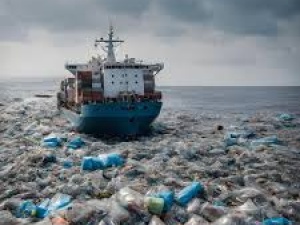Introduction Plastic pollution in our oceans has become a growing environmental crisis, with millions of tons of plastic entering the seas every year. This pollution is having a devastating impact on marine life, ecosystems, and even human health. According to a study by Science Advances, humans have produced 8.3 billion metric tons of plastic since the 1950s, and about 60% of that plastic has ended up in either a landfill or the natural environment, including the oceans. In this blog post, we’ll take an in-depth look at the scale of plastic pollution in oceans, the various sources contributing to this issue, and the measures needed to combat this global crisis. The Scale of Plastic Pollution in Oceans It is estimated that approximately 8 million tons of plastic enter the oceans annually. This number continues to grow, and if current trends persist, by 2050, there will be more plastic than fish in the oceans, according to a report by the Ellen MacArthur Foundation. A 2020 study revealed that between 24 and 34 million tons of plastic waste is dumped into the ocean each year. This plastic doesn’t disappear; instead, it breaks down into microplastics — tiny particles less than 5 millimeters in size. Today, there are an estimated 51 trillion microplastic particles in the ocean, weighing nearly 269,000 tons. These microplastics are found in nearly every marine organism, from plankton to whales, and even in the fish that humans consume. Key Sources of Plastic Pollution There are various sources that contribute to plastic pollution in oceans. The top sources include: Land-based activities: Around 80% of ocean plastic comes from land-based sources, such as littering, poorly managed landfills, and runoff from urban areas. Rivers act as conduits, transporting plastic waste from inland areas to the seas. The Yangtze River alone contributes an estimated 1.5 million tons of plastic to the ocean each year. Fishing and shipping industries: Lost or abandoned fishing nets, commonly known as “ghost nets,” make up roughly 10% of the total ocean plastic. These nets pose a significant threat to marine life, entangling and often killing fish, turtles, and marine mammals. Single-use plastics: Items like plastic bags, straws, and packaging material are major contributors to the pollution crisis. Each year, 500 billion plastic bags are used globally, and many of these find their way into the ocean. Impact on Marine Life The impacts of plastic pollution on marine life are staggering. Over 100,000 marine mammals and 1 million seabirds die each year from ingesting or becoming entangled in plastic debris. For example, a study found that 90% of seabirds have ingested plastic at some point in their lives. Sea turtles often mistake plastic bags for jellyfish, and once consumed, the plastic can cause blockages in their digestive systems, leading to starvation. Microplastics, in particular, have far-reaching consequences. These particles can absorb toxic chemicals from the water, and when ingested by marine organisms, they can bioaccumulate through the food chain. Research indicates that over 700 species are affected by plastic ingestion, and the toxic chemicals can eventually make their way into human food sources, posing health risks. The Economic Cost of Plastic Pollution Plastic pollution not only affects marine ecosystems but also has significant economic consequences. A study by the World Wildlife Fund (WWF) estimates that the global cost of marine plastic pollution is around $13 billion annually. This cost includes losses in tourism, fishing, and shipping industries, as well as the cost of clean-up efforts. For example, in 2019, the fishing industry in the United States faced losses exceeding $2 billion due to the damage caused by marine debris. Similarly, beach clean-up efforts cost countries millions each year. In the UK alone, it’s estimated that the cost of removing plastic litter from beaches exceeds £18 million annually. Solutions to the Crisis There are several global initiatives aimed at reducing plastic pollution in the oceans. Some of the most impactful measures include: Reducing plastic production: Governments are beginning to ban or limit the use of single-use plastics. For example, the European Union banned certain single-use plastic items such as straws, plates, and cutlery in 2021. Improving waste management: Enhancing waste collection systems, particularly in developing countries, can significantly reduce the amount of plastic entering the oceans. Innovative technology: Ocean clean-up efforts are also on the rise. The Ocean Cleanup project, for instance, has developed technologies that can remove large quantities of plastic from the oceans. In 2021, the project removed 28,659 kg of plastic from the Pacific Ocean during one of its missions. Education and advocacy: Raising public awareness about the importance of reducing plastic consumption and proper waste disposal can help reduce the amount of plastic pollution. References
